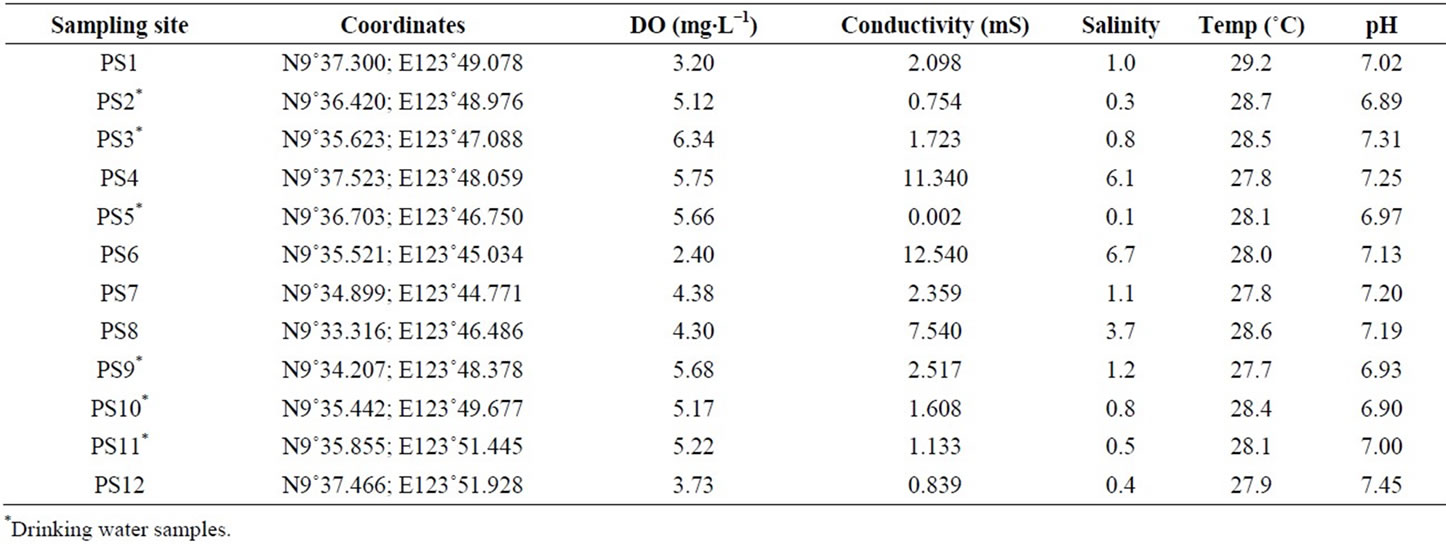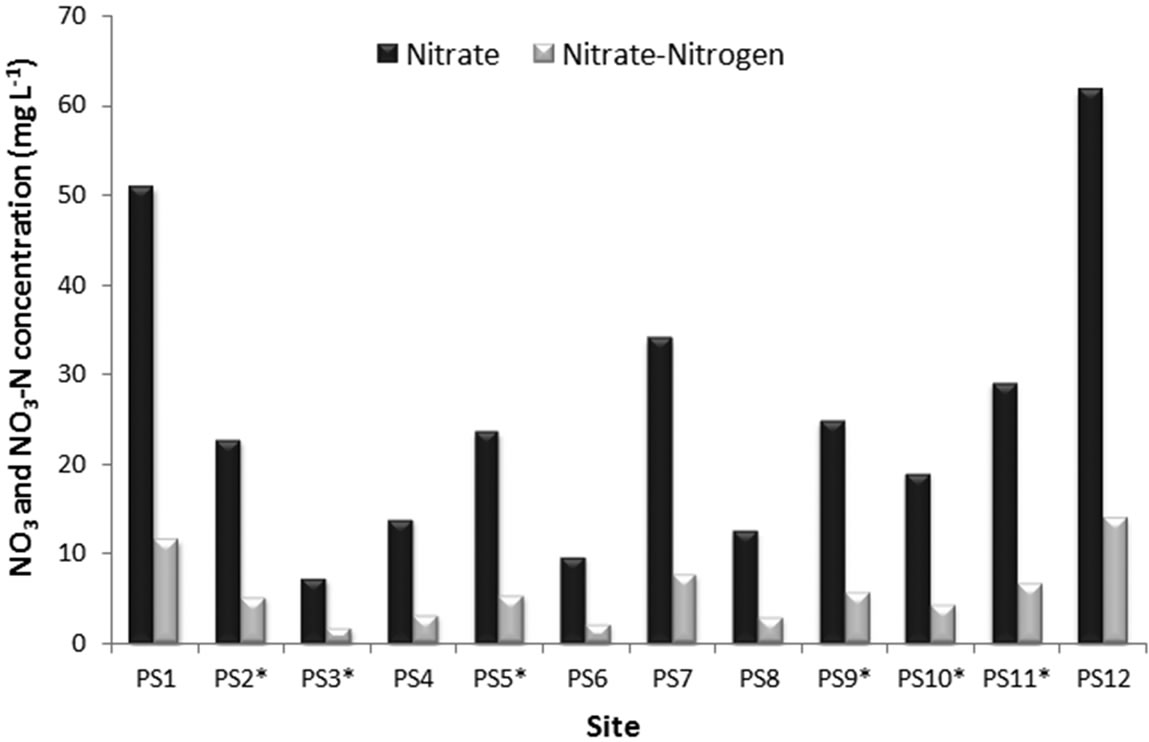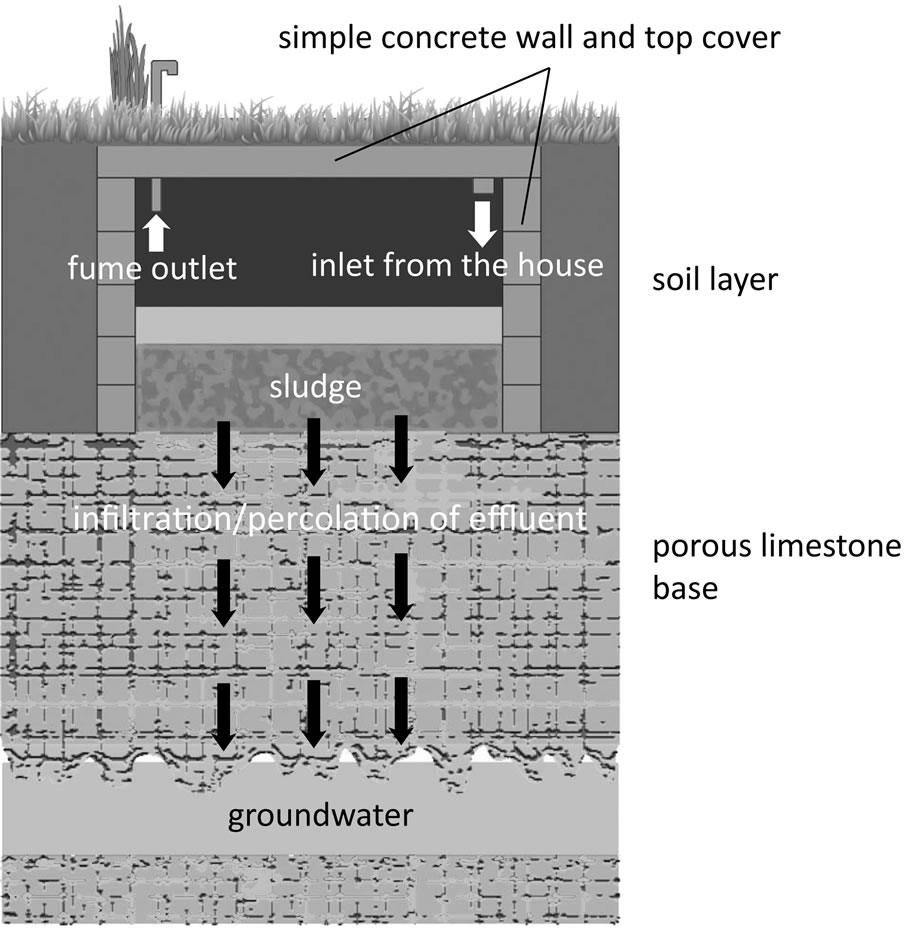Concealed Environmental Threat in the Coastal Region Requires Persistent Attention: The Panglao Island, Philippines Example ()
1. Introduction
The coastal areas are known to be one of the world’s fastest growing areas for development ever since the ancient times. However, development is usually accompanied by environmental threats if not properly managed and, more often than not, people and authorities react when the problem is already apparent (or the surrounding community is already affected). The case of the underground system that is not readily visible is oftentimes out of people’s concern making it the least priority. Humans do not care much about their activities on the surface environment that may impact the hidden subsurface environment. Over extraction of groundwater, for example, could result to the decline of the water table that causes loss of buoyant support to the overlying rocks, which will eventually lead to catastrophic land subsidence [1].
Overexploitation and mismanagement of groundwater resource could lead to the depletion and degradation of water quality [2] as well as saltwater intrusion. Moreover, changes in the physicochemical properties of groundwater are known to affect the physiological development of aquatic biota (e.g. [3-6]). The overall effect will eventually affect the well-being of the human population who are at the losing end. People should therefore be aware of such concealed environmental threats before it becomes too late.
Panglao is a small island located in the central part of the Philippines (Figure 1). It is divided into two municipalities, Dauis on the east and Panglao on the west, with a total land area of 95.07 km2 and bounded by 49.17 kilometers of coastline. The island’s population in 2007 is 62,083 with an average growth rate of 1.5% according to the record of the National Statistics Office (NSO) of Dauis and Panglao municipalities. Panglao Island is economically important for the province of Bohol because of

Figure 1. Map of the Philippines showing the sampling sites in Panglao Island.
its tourism industry. This island is known globally for its world-class beach resorts making it frequented by many local and foreign tourists. Bohol provincial tourism office recorded an escalating number of visitors from 128,899 in 2003 to 282,498 in 2008 and was projected by the Bohol Provincial Planning and Development Office (PPDO) to be four times higher in the next ten years and that is on top of its local population that is also increasing every year. Incidentally, [7] detected high concentrations of ,
,  and Cl− in the groundwater of Panglao Island and suggested to have further investigations on what could be the possible cause/s or source/s of the contamination.
and Cl− in the groundwater of Panglao Island and suggested to have further investigations on what could be the possible cause/s or source/s of the contamination.
On the other hand, Panglao Island is rich in biodiversity. Reference [8] reported that initial estimates of more than 7000 species were sampled during the 2004 marine expedition in the surrounding sea. This does not include the terrestrial species and those species inhabiting the groundwater of this small island (e.g. [9-12]). While unique cave (groundwater) species have been discovered and described in various parts of the Philippines in recent years (e.g. [13-15]), some of which belong to a higher taxa like new genus [16]) or even a new family [17], it’s also possible that there are more undescribed species inhabiting the groundwater of Panglao Island.
This study aimed to assess and identify the problems that exist in a “healthy-looking” coastal area. We intend to provide examples of environmental issues that are frequently overlooked and ignored but could be a serious threat if not properly checked.
2. Materials and Methods
Water samples were collected from 12 sampling points (indicated PS1 to PS12) from deep wells and caves in the island of Panglao, Bohol, Philippines (Figure 1) in May 2011. They were analyzed at the University of the Philippines-Natural Sciences Research Institute (UP-NSRI) for microbial content and chemical contaminants.
2.1. Microbial Analyses
Separate analyses were conducted for environmental samples (water samples not ideal for drinking) and those water that is used for drinking.
1) Environmental Water Samples
The samples were serially diluted up to 10−2 analyzed by multiple tube fermentation technique (MTFT) using 5 of 1-ml portions of the undiluted sample (100) and the 10−1 and 10−2 dilutions. The presumptive test for coliform bacteria was done on single strength lauryl sulfate tryptose broth (LST). The LST tubes were incubated at 37˚C and observed for gas production within 24 - 48 hours. To confirm the presence of coliform bacteria, gassing LST tubes were sub-cultured into brilliant green lactose bile broth (BGLB). BGLB tubes were incubated at 37˚C and observed for gas formation within 24 - 48 hours. Gassing LST tubes were likewise sub-cultured into EC broth to confirm the presence of fecal coliforms. EC tubes were incubated at 44˚C and observed for gas formation within 24 hours.
The most probable number (MPN) of coliform bacteria per 100 mL sample were determined from the MPN table for 100, 10−1 and 10−2 dilutions.
2) Drinking Water Samples
The samples were analyzed by MTFT using 5 of 20- mL volumes of the sample on triple strength LST, 5 of 10-ml volumes in double strength LST and 5 of 1-ml and 0.1-ml volumes on single strength LST. Procedures to determine presumptive and confirmed fecal coliform levels, as in the environmental water samples, were followed.
The water samples contained high levels of coliform bacteria for drinking water, hence, values obtained using 20-ml volumes were not considered. The MPN levels of coliform bacteria were based on 10-, 1- and 0.1-ml volumes of the sample.
2.2. Water Physico-Chemical Analyses
Dissolved oxygen, conductivity, salinity and temperature were measured using YSI 85 while pH was measured using Custom Waterproof pH meter. These parameters were measured in situ during water sampling.
Chloride and nitrate were analyzed using ion chromatography, nitrite using colorimetric N-(1-naphthyl) ethylene diamine dihydrochloride reagent method while Atomic Absorption Spectrophotometry (AAS) Flame method was used to analyze sodium following the standard methods for the examination of water and wastewater [18].
2.3. Survey and Interview
People aged 14 to 84 years old, 90% of them have resided in Panglao Island for 10 years or more, were interviewed during our survey in 2011. One hundred fifty (150) respondents were selected randomly from different areas of the island of which 11 were discarded due to questionable response leaving a total of 139 valid respondents. Questions regarding family background, their environmental and economic points of view on Panglao Island were asked and scored in a sheet.
3. Results and Discussion
3.1. Microbial
The results show high levels of coliform bacteria in all the groundwater sampling sites in Panglao Island (Figure 2). It ranged from 2 to 16,000 MPN/100mL. All the sites that were sampled for environmental water quality test were all contaminated with fecal coliform bacteria with the highest concentration in site PS4 (16,000 MPN/ 100mL) and with the least concentration in site PS1 (20 MPN/100mL). All the wells that are currently being used for drinking water (PS2, PS3, PS5, PS9, PS10 and PS11) are contaminated with fecal coliform bacteria. The highest concentration was detected in site PS2 (1600 MPN/ 100mL) and least in PS10 (2 MPN/100mL).
None of the sites passed the standard for drinking water or for recreation use. This is a clear indication that even though there is no apparent sign of human disturbance, deterioration of groundwater system is very evident.
3.2. Physico-Chemical
Table 1 summarizes the environmental parameters of groundwater obtained from Panglao Island. The pH was all within the normal range from 6.89 to 7.93. Dissolved oxygen (DO) ranged from 2.40 to 6.34 mg∙L−1, PS3 having the highest concentration and PS6 the lowest. Temperature ranges from 27.7˚C to 31.6˚C. Water conductivity ranged from 0.002 to 57.4 mS and salinity from 0.1‰ to 6.7‰, PS6 has the highest concentration of both parameters while PS5 has the lowest. Low DO concentration in site PS6 is quite noticeable as well as high EC and salinity.
Sodium ion concentrations (Figure 3) ranged from 53.4 to 2120 mg∙L−1. Site PS6 has the highest concentration while PS12 has the lowest. Chloride ion concentrations (Figure 3) ranged from 33.8 to 3430 mg∙L−1 with the highest concentration in PS6 and lowest in PS12. Note that PS12 has higher concentration of sodium than chloride unlike the other sites in which chloride ions are almost twice the sodium ions concentrations.

Figure 2. Coliform counts of Panglao Island groundwater samples. Sites with asterisk (*) indicate drinking water samples.

Table 1. Aquatic environmental parameters of groundwater in Panglao Island.

Figure 3. Concentrations of sodium and chloride ions in various parts of Panglao Island. Sites with asterisk (*) indicate drinking water samples.
Nitrate concentrations (Figure 4) ranged from 7.2 to 61.9 mg∙L−1 with the highest concentration in PS12 and lowest in PS3. PS1 and PS12 sites both have above maximum contaminant level (MCL) for NO3-N (11.59 and 14.07 mg∙L−1 respectively). Nitrite concentrations on the other hand ranged from less than maximum detection limit (MDL) up to 0.025 mg∙L−1 (data not shown). This high concentration of nitrate in drinking water poses a serious threat to human health especially to babies. Nitratenitrogen concentration as low as 10 to 20 mg∙L−1 is known to cause illnesses and even deaths among infants under six months of age.
3.3. Local People’s Perspective
Our random interviews with the local people gave some insights on the situation in Panglao Island as well as some perspective of the residents. Highest number of the respondents use municipal water supply (38.7%) which is a centralized deep well in the island followed by those using purified (33.8%). About fifteen percent (14.9%) utilizes water from their private deep well for their daily consumption while the rest are using bottled water (9.3%) and other sources not mentioned (3.3%).
Twenty-seven percent (27%) of the respondents noticed changes in the quality of water during their entire life in the island in terms of taste and color while 73% said there’s no change, however, some of them commented that the water from the deep well tastes a little brackish.
In terms of the possible sources of pollution in Panglao the respondents admitted that the local people are the main source of pollution (53.7%) while the rest are coming from local industry (19.9%), natural cause (15.4%), tourism (9.6%) and agriculture (1.5%). In this respect,

Figure 4. Nitrate and nitrate-nitrogen concentrations of groundwater in Panglao Island. Sites with asterisk (*) indicate drinking water samples.
most people believe that beaches (51%) are the most threatened natural resource in Panglao Island as a result of island development. The other half believed that mangroves (15%), groundwater (13.6%) and caves (12.9%) are also threatened while the smallest percentage of the respondents (6.8%) is not aware of the threat. If pollution will not be controlled, 49% said that beaches would be the most affected followed by groundwater (21%), mangroves (10.2%) and caves (9.5%). While 8% are not aware, 1.5% said that there is no threat at all.
Majority of the respondents (46.6%) believed that tourism is the major source of local employment while 19% said it is the major driver for the development of Panglao Island. Others said that tourism causes the increase in population (17.2%) and pollution (13.2%) while 4% said it causes environmental destruction.
Most of the respondents (46.6%) claimed that Panglao Island in general is a good place for business and employment opportunities. Others know that this island has high biodiversity (19%), overcrowded and polluted (17%), a paradise and tourist destination (13.2%) and 4% said it’s a sanctuary for plants and animals.
3.4. Potential Impacts to the Environment
Tourism attracts migration, temporarily and permanently, because of the aesthetic value of the place as well as the employment and business opportunities. These can result to the increase in local population, which if not checked and regulated will skyrocket beyond the local environment’s carrying capacity and the ecosystem’s resilience to stressors. This chain reaction could lead to ecological disaster and collapse. The high concentration of nitrate, the presence of coliform bacteria and the increasing groundwater salinity is quite alarming. The presence of these pollutants in coastal groundwater is a clear indication of ignorance and invisible but potentially devastating impacts of human activities to the environment. Local population of the island relies on groundwater (municipal water supply) and the changes in its quality have made the people without a choice but to use purified or filtered water. This issue will become a bigger problem in the long run if the local residents could not afford the (more expensive) potable water for their basic needs.
Contamination of Panglao Island’s groundwater with coliform bacteria could primarily be due to the current design of septic tanks as observed personally by the first author (see illustration in Figure 5). The lack of waterproof flooring allows the infiltration of waste from the septic tank through the porous limestone base. This contaminated water could easily disperse to the groundwater of the entire island as noticed with the water quality analyses. High chlorine concentration on the other hand could be attributable to the combination of seawater intrusion and application of free chlorine directly to the open wells to disinfect the water for drinking. Sanitation techniques however seem to be ineffective because coliform bacteria in the groundwater were detected.
The groundwater serves as corridor for migrating animals in areas where surface water such as rivers are not present [19,20]. It is also a refuge and breeding ground for some aquatic animals (unpublished report). In this

Figure 5. Conceptual model of the common design of septic tanks in Panglao Island illustrating the infiltration of effluent/ polluted water through the porous limestone base that causes contamination of the groundwater.
regard, the quality of groundwater will play a vital role in the survival of organisms that depend on it. Aquatic nutrients are important but their excess amounts could be detrimental to the health of the groundwater organisms.
3.5. The Need for a Strategic Management Plan
Panglao Island, though small, is rich in natural resources but these will vanish if not properly managed and taken cared of. Without strong consideration to the biodiversity and natural environment, the island’s natural aesthetic quality will collapse in due time. Marine and coastal regions are known to be experiencing the fastest tourism growth among other areas in the world [21] and yet most people are still unaware of its negative impact on the fragile coastal ecosystems. Development of resorts along the coast is economically valuable but ecological consideration and proper management should be implemented in strictest sense. They should not threaten the biodiversity and selfishly exploit the natural resources for the benefit of the few; hence strong political support for sustainable development is deemed essential.
It is important to note that protecting the underground environment does not rely solely on the protection of the groundwater, but also on the protection of the surface environment as well. The rate of percolation to groundwater is higher in the karst regions thus inhibiting the natural mechanical and biological self-purification of the polluted rainwater that passes through the subterranean cavities [22]. Any pollutants on the surface have the potential to percolate into the groundwater as well. The bigger problem is that once the pollution enters the groundwater, it is difficult to trace its source [23] and by the time it is detected, the pollutant is likely to be widespread and the damage is already irreversible [24].
4. Conclusions and Recommendations
The community within Panglao Island was not aware of the situation because the negative effect of anthropogenic activities to the environment appears to be virtually absent. These findings clearly suggest the vulnerability of the groundwater resources from human activities because of its hidden location (see also [14]). Repercussions of human activities may not be manifested yet while the disturbance is ongoing, but sooner or later their long term effect will be more apparent.
As in the case of Panglao Island, many areas around the world are unfavorably impacted by tourism and threatened by its associated activities, thus, understanding the physiology of underground ecosystem is critically important so that a proper management plan will be implemented. Reference [7] recommended that the surface environment should be protected in order to preserve a good groundwater quality. Therefore, revisiting the current local policy with regards to environmental protection is quite appropriate so that necessary measures will be improved and not be overlooked. Higher standard for the coastal development plan, strict environmental monitoring, especially of groundwater, and public awareness on coastal issues will be beneficial to all concerned especially those people relying on coastal resources.
5. Acknowledgements
We would like to thank the people of Panglao Island who participated in the survey and the local government staffs and mayors of the municipalities of Panglao and Dauis for permitting and supporting this study as well as for providing some local data. Our sincere gratitude is also expressed to Dr. C.G.B. Banaay whose constructive comments and suggestions helped improve this manuscript. The first author is grateful for the assistance provided by the Yokohama National University during his postdoctoral research fellowship. This work was supported in part by Global COE Program, MEXT, Japan.
NOTES